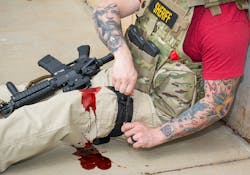Almost by definition, an active shooter event requires casualties. While it would be fantastic if an active shooter event occurred and no one got shot, the chances of that occurring are slim and if such an event ever occurred it would almost be the joking side note of the nightly news, “...the shooter so incompetent that he managed not to shoot anyone.”
Given the connection between an active shooter event and an assumed high number of casualties, fatal or otherwise, the need for immediate trauma care is a given. What’s not as common and assumed is the reality of such. While many law enforcement agencies are getting on board with the idea of providing trauma training to their officers for gunshot extremity wounds, beyond that level of training is often either viewed as unnecessary, unaffordable or an unacceptable increase in potential liability.
The reality
Responding officers have three immediate responsibilities on the scene of an active shooter event:
- Neutralize the threat
- Secure the scene
- Assist with recovery and mitigation. This includes triaging and treating life-threatening wounds on responding officers as well as every victim on the scene.
What most agencies train for are the first and second bullet points. Get there. Neutralize the threat. Verify there are no additional threats. We most often train to assist emergency medical services personnel as they triage and treat the wounded. As an example of how overwhelming an event can be for them, we look back to Seung Hui Cho’s attack at Virginia Tech, on a day where helicopters could not fly to evacuate wounded, and when there were only five ambulances plus personnel available for response. Yet there were 30+ people shot or otherwise wounded on scene. The two SWAT Medics on the scene that horrific morning more than earned their entire life’s salary in that few hours of work. Every other officer who was on the scene, once the threat had been neutralized and the scene secured could have been serving as a trauma medic if they had been properly trained and properly equipped.
We shouldn’t be waiting for the next event wherein someone gets shot and nothing is done about it while several officers stand around making sure no more shooters pop up. If the threat is neutralized and the scene secured, every available officer should be assuming the secondary role of first response: trauma care. While the reality of budget restrictions exists, the potential liability from a single incident could far outweigh the initial and on-going cost of training.
A study done several years back on preventable deaths in current combat zones showed that death from blood loss due to extremity wounds was the number one preventable cause of death. That means bullet, edged weapon or shrapnel wounds to the arms or legs that created sufficient blood loss for the victim to die. Those deaths are easily preventable with a fairly minimum level of training and just a few pieces of first-aid equipment. These could be the same pieces we issue our officers for their own bullet wound to an extremity, just in greater quantities.
Additionally, for the officers who show any talent or interest in the trauma care protocols, training for response to sucking chest wounds and the linked tension pneumothorax injuries can be delivered. Even more lives could be saved with those skills.
Know what’s in your kit and how to use it
One example of such a kit is produced by Combat Medical. They produce products for blood loss control, airway maintenance, respiratory assistance, head trauma, shock treatment, hypothermia and more. On their website you can find complete kits for treating multiple gunshot wound victims, or a single victim with multiple gunshot wounds—which is often a reality in an active shooter event.
It is vital to understand, however, that the two essentials go hand in hand: it is useless to provide training and not provide the equipment to go with it. It is useless (or near to it) to provide the equipment and not the training to use it properly. Every agency in the country training for active shooter response needs to expand their training focus from “arrive, go in, shoot and secure,” to those items plus “triage, treat and assist with evacuation.” Failing in that, we are not fully serving our public or fulfilling our purpose.
Training coordinators should be integrating casualty management into their response scenarios and practical skills training/testing. This should include triage, treatment and evacuation as well as triage and “hand off” for those victims if the officer isn’t trained or equipped to a high enough level to treat. That recognized, no casualty should go untreated simply because the agency decided officers only needed advanced first-aid training or an IFAK only for themselves. Our responsibilities go far beyond treating our own injuries and we need to make sure that responsibility is one we are trained and equipped to fulfill.
Download the full 2019 Active Shooter Response Supplement at Officer.com/21081202.

Lt. Frank Borelli (ret), Editorial Director | Editorial Director
Lt. Frank Borelli is the Editorial Director for the Officer Media Group. Frank brings 20+ years of writing and editing experience in addition to 40 years of law enforcement operations, administration and training experience to the team.
Frank has had numerous books published which are available on Amazon.com, BarnesAndNoble.com, and other major retail outlets.
If you have any comments or questions, you can contact him via email at [email protected].



